If you’ve ever purchased a value meal with fries, a burger, and a drink, you’ve experienced the effectiveness of bundling. Known as “packaged deals,” product bundles combine multiple items or services into a single package for consumers.
It’s no wonder that Amazon, the world’s largest retailer, offers many items in bundles and allows other sellers on its platform to do so. Amazon product bundles mean combining two or more items sold as a single package at a discounted price. The items in a bundle are complementary, meaning they work well together, making shopping more convenient for the buyer.
So, how can you jump into selling Amazon seller bundles? Without further ado, check this article to learn:
- What is a Product Bundle on Amazon?
- Does Amazon allow product bundles?
- How to bundle products on Amazon?
- How to sell Amazon product bundles?
- How to find products to bundle?
- Pros and cons of selling product bundles
Let’s dive right in!
What is a Product Bundle on Amazon?
On Amazon, product bundling means combining two or more items that complement each other and selling them as one package. These items might work together, serve a similar purpose, or just make shopping easier for the buyer. Amazon product bundles are like a complete solution for customers. Instead of searching for each item separately, they can get everything they need in one package. This is great for busy shoppers who want a simple shopping experience.
Amazon bundle examples
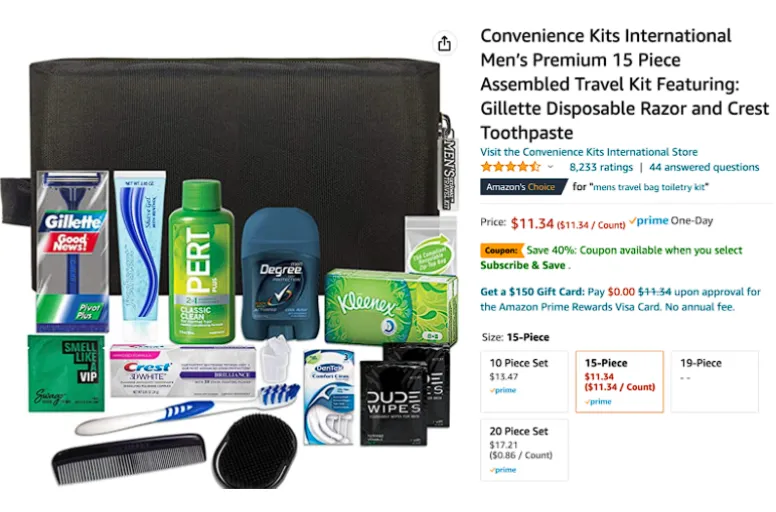
Here’s an example of a men’s travel kit sold as a bundle on Amazon. It includes different toiletry items packaged together for sale. Bundling these items lets customers purchase several related products at a lower price, providing convenience and savings.
Whether it’s salt and pepper sets or skincare products, there are countless Amazon product bundles to sell on Amazon.
Bundles vs kits vs multipacks
Bundles, kits, and multipacks may appear similar, as they all include multiple items in a single package. However, they have distinct differences. Understanding these variances can prevent issues and potential suspensions from Amazon.
Bundles vs kits

A kit often combines several individual items into a “kit” to create a new product. These items may relate to each other or complement each other, but they’re not sold separately. For instance, a crafting kit might include figurines, paint, and decorations for painting.
On the other hand, Amazon product bundles consist of multiple single items, each with its own ASIN/UPC, sold together as a unified package. Bundles offer more flexibility by combining different products from various categories or brands, offering customization and variety.
Note: If you’re private labeling and wish to group your products into one package, you can create your Amazon seller bundles without adhering to the bundling guidelines.
Bundles vs multipacks
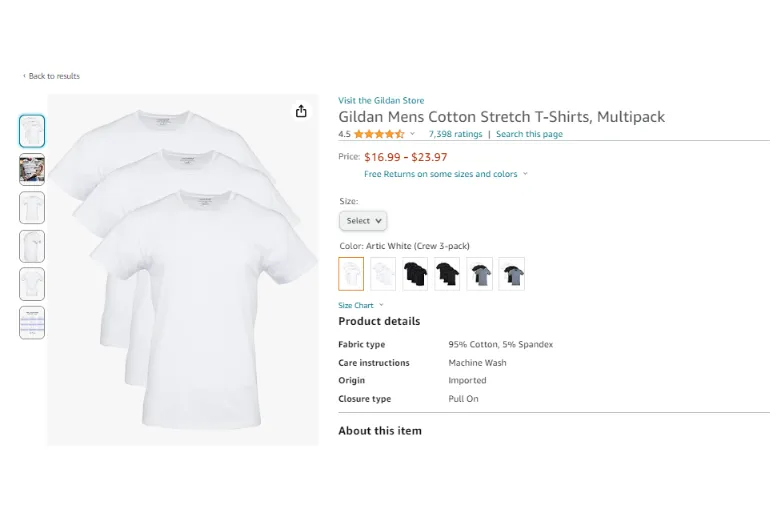
Amazon product bundles merge various items into one package, whereas multipacks contain multiple units of the same item in a single package. Bundles offer diversity and complementary products, while multipacks provide convenience and cost savings on identical items.
Does Amazon Allow Product Bundles?
Some of you might be curious whether Amazon permits bundling multiple brands and products under one listing. And, YES, it does!
We wouldn’t advise any business practices that go against Amazon’s Terms of Service. We actually encourage you to thoroughly review Amazon’s Product Bundling Policy if you’re considering selling a product bundle.
Amazon’s detailed bundle policy
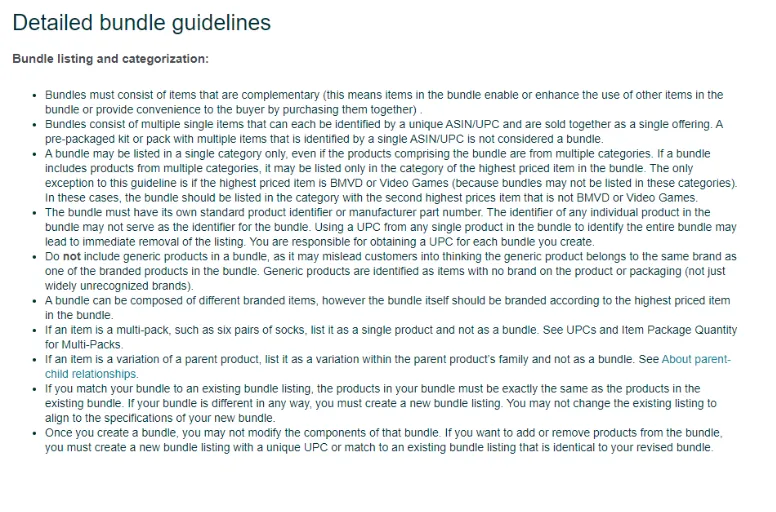
Below are some of Amazon’s specific bundle guidelines.
- Amazon product bundles should include items that complement each other well, meaning they either enhance each other’s use or provide convenience when purchased together.
- A bundle can include items from different brands.
- Bundles are made up of multiple individual items, each with its own unique identification code (ASIN/UPC), and they are sold together as a single package.
- The bundle must have its own distinct product identifier or manufacturer part number. Using the UPC of any single product within the bundle to represent the entire bundle may result in removing the listing. You need to get a UPC for each bundle you create.
The last point is crucial: if you’re selling a bundle of individual products, you need to obtain a unique UPC specifically for that bundle.
There are more rules set by Amazon for bundles. These rules are:
- Sellers need to have a good history on Amazon and at least a 3-star rating.
- None of the items in the bundle should be restricted or offensive.
- The bundle needs to be eligible for Prime shipping in all regions.
- All items in the bundle must be brand new.
- The bundle needs to follow Amazon’s rules for customer reviews.
- The bundle’s pricing needs to be fair, and it must have a valid reference price.
- The bundle needs to meet Amazon’s requirements for how often deals can be offered.
How to get a UPC for your bundle
Every branded product in your Amazon seller bundles will have its own distinct UPC, but you can’t utilize those when setting up the listing. Here’s how you can do it:
- Visit the GS1 website and buy a UPC for your specific brand name. Previously, obtaining a UPC from GS1 for 1-10 UPCs cost at least $250. However, you can now buy a one-time use UPC for only $30, without any yearly renewal charges.
- Once you have the UPC, you can create your own distinct bundled listing on Amazon!

How to Bundle Products on Amazon?
Ready for the next steps? Keep scrolling down for our detailed guide on how to bundle products to sell on Amazon
Step 1: Finding the right products to bundle
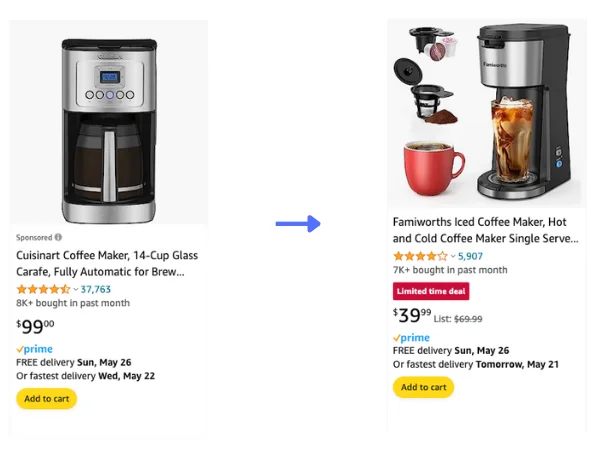
- Look for complementary Products: Think about items that customers typically buy together. For example, a coffee maker could be bundled with coffee filters and mugs.
- Utilize the “Frequently Bought Together” section: Amazon offers valuable insights into buying habits through this feature. See what products are frequently purchased alongside your main product and consider bundling them.
- Research with product databases: Tools like Jungle Scout can help you identify popular products and analyze their sales trends. This can guide your bundle creation.
Step 2: Building your product bundle
Now that you completed choosing the products to bundle, here are a few suggestions that we think might help:
- Brand consistency: The bundle should be branded according to the highest-priced item within it. You can include different brands, but ensure it’s clear which takes precedence. Maintain a clear brand identity for a cohesive and trustworthy bundle.
- Avoid restricted products: Video games and BMVD (Books, Music, Videos, DVDs) cannot be the primary item in a bundle. They can be secondary if they complement the main product. Be aware of Amazon’s restrictions to avoid any hiccups in listing your bundle.
- No duplicates or pre-existing kits: Don’t confuse your bundle with existing multi-packs or pre-made kits already available on Amazon. Offer something unique and avoid replicating what’s already there.
Step 3: Obtaining a UPC or GTIN exemption
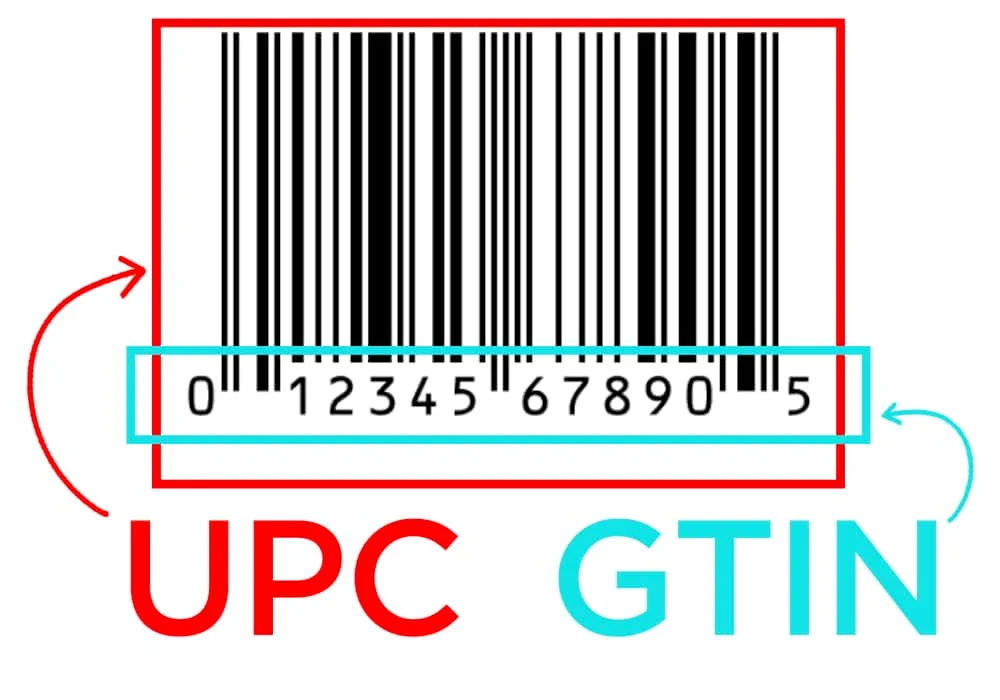
As mentioned above, you’ll need a special code to officially list your bundle on Amazon:
- Unique UPC: If your bundle consists of various brands, you’ll need a unique UPC code. You can purchase one from GS1. This code acts like a unique fingerprint for your one-of-a-kind bundle.
- GTIN exemption: If the products are all from the same brand, you can request a GTIN exemption from Amazon. If your bundle features a single brand, you can potentially avoid purchasing a UPC code by requesting an exemption.
Step 4: Creating your bundle listing
Now it’s time to bring your Amazon product bundles in front of your potential buyers. At this step, you will need to:
- Fill in your product info: Gather details like product names, descriptions, and high-quality images showcasing the bundled products together. Compelling descriptions and high-quality visuals are essential to grab attention and convince customers.
- Create your listing: Through Seller Central, navigate to “Inventory” and choose “Add a product.” Specify you’re adding a new product and follow the prompts. Follow Amazon’s guidelines to create a smooth and successful listing process.
- Highlight the bundles: Clearly emphasize in the title, description, and bullet points that you’re selling a bundle. Make it crystal clear to shoppers that they’re getting a value-packed bundle.
Who wants to spend hours just listing everything? LitCommerce – a powerful multichannel selling tool is here to help! Our easy-to-use listing tool lets you upload and manage your Amazon listings.
Step 5: Optimize your bundle for sales
People are naturally drawn to good deals. By offering your bundle at a discounted price compared to buying the items individually, you create a clear incentive for customers to choose your bundle. That’s why this bonus step is vital for turning your Amazon product bundle into a bestseller.
- Price your package smartly: Offer the bundle at a discounted price compared to buying the items individually. This entices customers to choose the bundle for better value.
- Write a compelling description: Explain why the products work well together and the benefits of purchasing them as a bundle. Don’t just list features, tell a story! Craft a description that highlights the convenience and value proposition of your bundle.
- Do marketing and promotion: Promote your bundle listings through Amazon PPC ads and other marketing channels to reach target audiences. Don’t wait for customers to find you. Proactively promote your bundle to get it in front of interested buyers.
Bonus tip: Why don’t you encourage satisfied customers to leave reviews for your bundle listing? Positive reviews can significantly improve the conversion rate, build trust and social proof, and influence future buyers.
How to Sell Amazon Product Bundles?
If you want to sell Amazon product bundles, below are three main ways:
1. Selling wholesale bundles on Amazon
This unique wholesale approach is easier than launching a new private-label product on Amazon. Especially when you have already purchased and resold other brands wholesale.
If you’re new to selling wholesale products on Amazon, here’s a quick explanation:
- Find a popular brand on Amazon.
- Create a wholesale account with that brand.
- Resell their products on Amazon without creating new listings or launching new products.
Selling wholesale Amazon seller bundles is an excellent strategy, although you might face competition for the buy box from other sellers sharing the same listing.
For instance, if you aimed to sell a box of RITZ Crackers alone, you’d need to list it alongside numerous other sellers (at least 3 for now). However, bundling compatible branded items together lets you create a unique listing where you’re the sole seller. This eliminates competition for the buy box entirely!
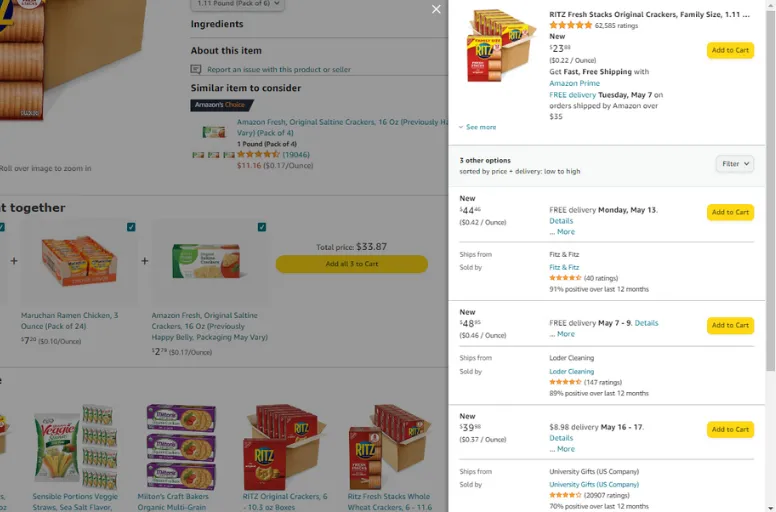
2. Selling your own private-label products
If you’re selling your own stuff on Amazon, it’s easier to pack things together in bundles. You can make special packaging for your bundle so it stands out. You can also mix your items with products of other brands, but only if you have their permission. Plus, just make sure everything follows Amazon’s selling rules.
If you can’t pack everything yourself, you can use a third-party FBA prep center. They’ll take care of labeling, repackaging, and shipping your Amazon product bundles. Selling product bundling for Amazon FBA makes running your Amazon business much easier.
3. Amazon’s Virtual Product Bundles (VPB)
Amazon has introduced the Virtual Product Bundles (VPB) program to streamline bundle creation for sellers on the platform. This program allows brand owners to digitally bundle up to five of their FBA ASINs into a listing. Virtual Amazon product bundles must consist of at least two ASINs, with each ASIN representing a separate product available on Amazon.
The VPB program is exclusive to brand-owning sellers using FBA. Quantities are automatically adjusted based on the lowest-stock item in the FBA inventory. Creating a VPB is free, enabling sellers to modify the product title, description, price, and images as needed.
When setting prices, sellers must ensure that their Amazon seller bundles are priced either lower than or equal to the combined prices of the individual products. Typically, sellers offer attractive discounts for bundle purchases compared to individual item purchases. However, Amazon cautions that bundles priced higher than the sum of their component prices may lose eligibility for the Featured Offer status.
Read more: Amazon Pricing Strategies.
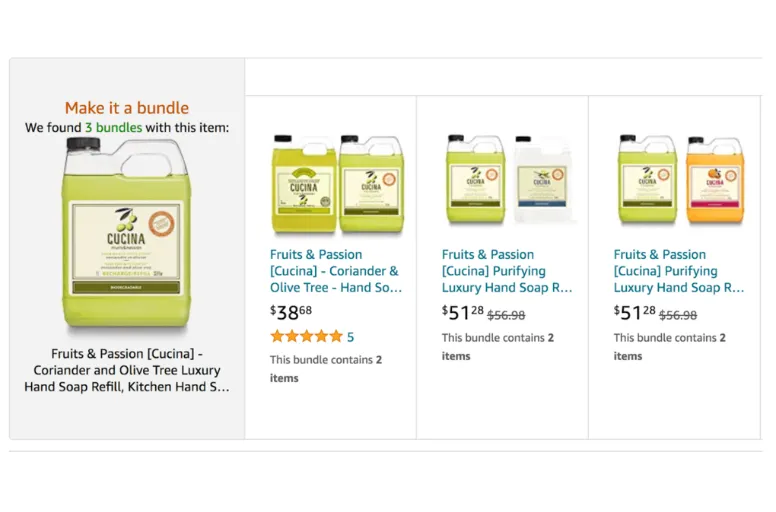
For more methods of finding products to sell, check our guide on how to source products to sell on Amazon.
How to Find Products to Bundle?
Just like with any business model on Amazon FBA, thorough product research is vital when selling Amazon product bundles. It’s crucial to ensure that the products you’re bundling not only complement each other in function or purpose but also have a high likelihood of selling well together. Here’s how to conduct product bundle research.
1. Search “Bundle” on Amazon
Sellers typically include the keyword “bundle” in the title of their product bundle listings, which makes it easy to identify them. This strategy often generates favorable results when searched properly. Instead of searching across all of Amazon, you can search to a specific product category and then use keywords like “bundle,” “kit,” or “pack.”
For instance, if you’re interested in browsing Amazon product bundles in the Electronic category, you can enter these keywords to find relevant listings. Analyzing these results can provide insights into which types of products tend to sell well together within that category.
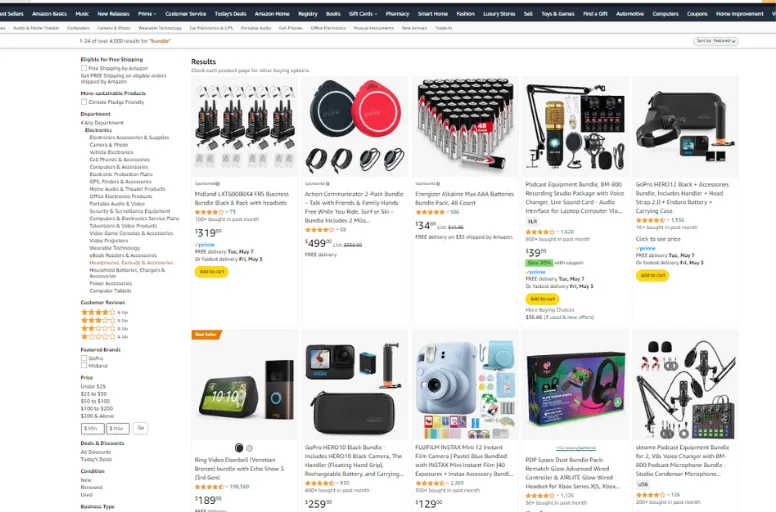
2. Look at the “Frequently bought together” section
If you’re not ready to invest in a tool, you can manually explore the “Frequently Bought Together” section. Your product detail page is an excellent starting point, as the suggested products will likely align well with your brand. Additionally, for broader options, it’s beneficial to examine the product pages within your niche. This broader approach can provide more insights and potential product pairing opportunities.
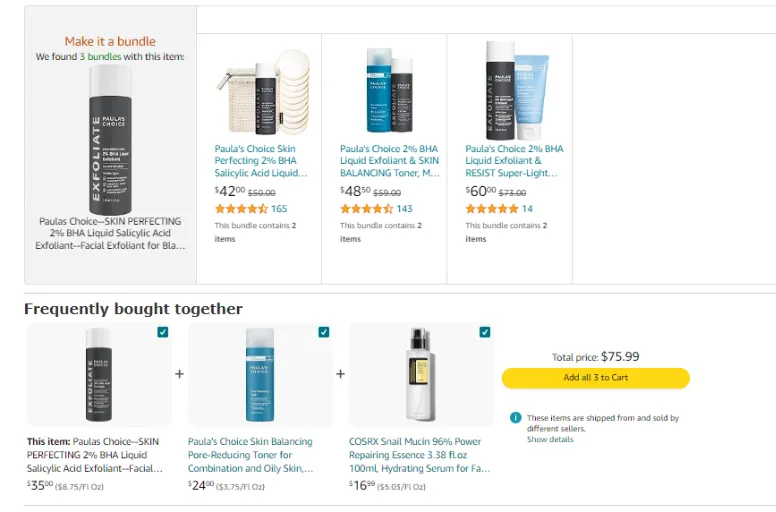
3. Use Amazon tools
Using analytic tools and doing Amazon competitor analysis offers a great advantage when you research products since it helps save time.
For instance, you can utilize Helium 10’s Black Box product research tool or Jungle Scout’s Product Database in this scenario to identify the ideal product bundles to focus on. These tools automatically scan Amazon’s Frequently Bought Together, Amazon Suggestions, and Customer Also Bought sections, eliminating hours of manual work.
Once you’ve identified your preferred bundle combinations, contact each brand to establish a wholesale account. This streamlined approach will help you create profitable Amazon seller bundles.
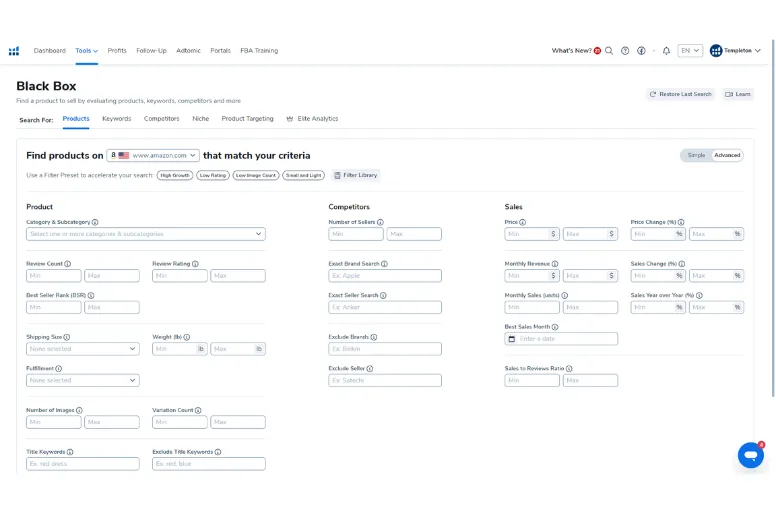
Pros and Cons of Selling Product Bundles on Amazon FBA
Before diving into selling Amazon product bundles, you can consider the potential drawbacks alongside the benefits.
Pros of selling product bundles on Amazon FBA:
- Increase average order value (AOV) as customers purchase multiple products in one transaction.
- Reduce competition for the buy box and gain greater control over pricing.
- Provide added convenience for buyers.
- Simplify product replenishment and sourcing from wholesale suppliers.
- Experience potentially lower PPC costs when selling popular brands compared to private label products.
- Stand out from competitors offering the same items with a unique approach.
What about its cons?
- Requires more effort than typical wholesale reselling, including finding complementary products, designing custom packaging, and obtaining a UPC.
- Not ensure that customers will like the Amazon seller bundles you make.
- Must accumulate reviews for a new listing instead of leveraging an established listing with sales history and reviews.
- May necessitate opening multiple wholesale accounts with different brands to assemble desired bundles.
- In some cases, require possession of a resale certificate and/or business license in your state.
Amazon Product Bundles: FAQs
Certainly! Amazon Seller Central allows sellers to offer product bundles, providing an avenue to showcase complementary items or variations together in a single listing. This approach enables sellers to present Amazon product bundles to customers, potentially enhancing the value proposition and shopping experience. There isn’t a set rule for the number of items in an Amazon product bundle. The focus is on creating Amazon seller bundles that add value and satisfy customer needs. However, if you join Virtual Product Bundles, you’re limited to including up to five ASINs for a bundle. Absolutely! Variations like different styles, sizes, colors, or flavors can be combined into a single bundle on Amazon. This approach allows sellers to offer customers a wider range of choices and tailor bundles to meet diverse preferences. For instance, you could create a bundle of shirts featuring various colors or a set of kitchen utensils available in different sizes.
Start selling profitable product bundles!
Bundling products can significantly elevate your customers’ user experience, offering them a convenient and streamlined method to purchase their preferred items. Whether you’re curating an at-home yoga package or assembling an essential toiletries set, Amazon product bundles can boost your sales and elevate your average order value.
If you want to consult with us about Amazon integration or anything related to eCommerce, don’t hesitate to contact us. LitCommerce is eager to help you with strategy and Amazon integration. You can also visit our blog for more helpful guides like this.
Happy selling!



